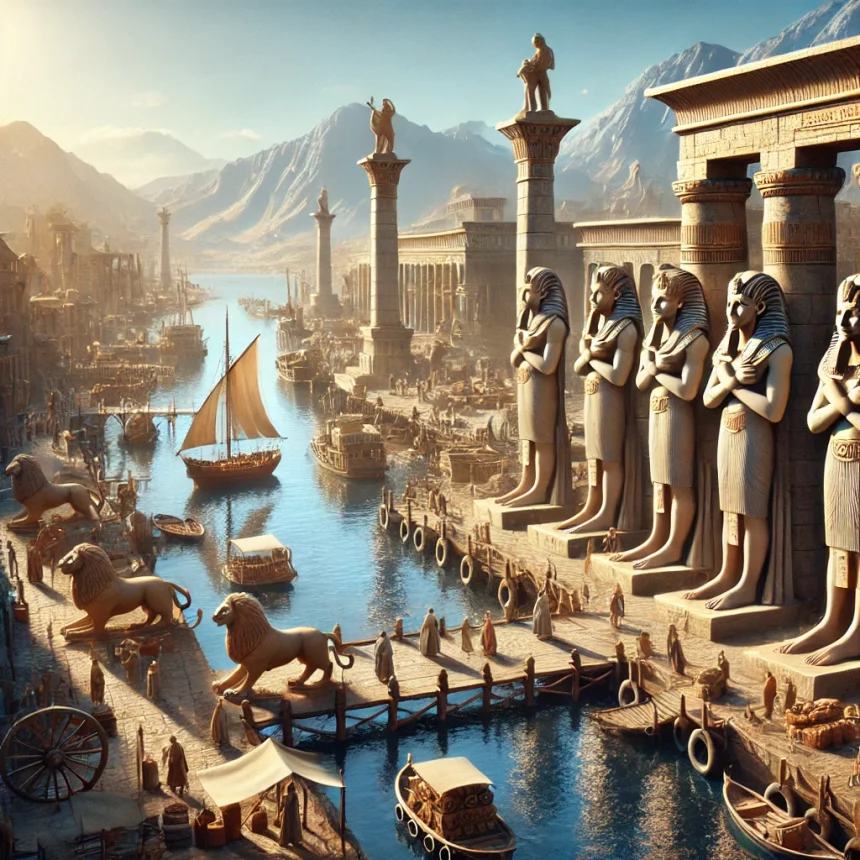An AI generated image of Heracleion before it sank to the sea
In Egypt, there’s a fascinating underwater mystery that’s been captivating archaeologists and history lovers alike: the ancient city of Heracleion (also known by its Egyptian name, Thonis). Once a bustling port city located near the mouth of the Nile, Heracleion was a key hub for trade and religion. But, over time, it vanished beneath the Mediterranean Sea. How this happened is still a mystery.
Heracleion was an important city as far back as the 12th century BCE and remained significant through the Ptolemaic period. The city got its name from the legendary Greek hero Heracles (Hercules), and the Egyptians called it Thonis. It played a crucial role as the entry point to Egypt for many foreign traders. However, sometime around the 2nd century CE, it disappeared under the waves, likely due to a combination of natural disasters like earthquakes, rising sea levels, and soil liquefaction (where the ground becomes unstable and sinks). Maybe it was an ancient tsunami?
For centuries, Heracleion was thought to be nothing more than a legend. That all changed in the year 2000, when French underwater archaeologist Franck Goddio and his team stumbled upon its remains buried under layers of sand and silt in Abu Qir Bay, not far from Alexandria.
Since its rediscovery, Heracleion has given us an incredible look at the past. Divers have uncovered massive statues, the remains of grand temples, and treasures that hint at the city’s wealth and influence.
Monumental Statues and Temples: Some of the most remarkable finds include giant stone statues of pharaohs and Egyptian gods. One particularly impressive statue is of Hapi, the god of fertility and abundance. These figures once stood in front of temples dedicated to deities like Amun and Osiris, towering over those who came to worship.
Ancient Ships and Sphinxes: Archaeologists have found over 60 shipwrecks in the area, as well as sphinxes and other relics. The ships, some of which were loaded with goods, offer a glimpse into Egypt’s role as a major player in Mediterranean trade.
Religious Artifacts: Heracleion was also a spiritual center. It’s believed that one of the city’s major roles was hosting religious festivals, like the Mysteries of Osiris. Processions would sail from Heracleion to the nearby city of Canopus as part of a sacred ritual. Many religious artifacts and offerings left by worshippers have been discovered in the ruins of the city’s temples.
Jewels and Coins: Among the treasures recovered are golden coins, jewelry, and weights that show just how prosperous the city was. These artifacts reveal how tightly Egypt was connected to the Mediterranean world, especially Greece, in terms of both trade and culture.
The discovery of Heracleion fills in the gaps about Egypt’s ancient past, but it also highlights just how interconnected civilizations in the Mediterranean were. The city was more than just a local port—it was a thriving center where goods, ideas, and cultures mingled.
The underwater archaeological research in Thonis-Heracleion is ongoing until today. Franck Goddio estimates that only 5 percent of the city have yet been discovered. Today, Heracleion is considered one of the greatest underwater archaeological finds ever made.
New discoveries are being made with each dive, revealing more about this long-lost city and its people. The underwater ruins continue to fascinate historians, explorers, and anyone with a love for ancient history.
Who is Franck Goddio? Franck Goddio is a pioneer of modern maritime archaeology. As the grandson of Eric de Bisschop (navigator, writer, inventor of the modern catamaran, and specialist of ancient navigational routes in the South Pacific), a passion for the sea and wanderlust runs in Franck Goddio’s veins.






